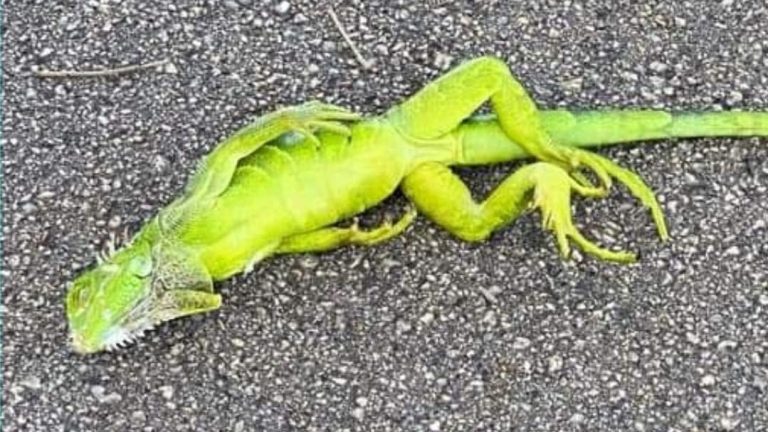
While there are things to be careful of throughout Florida — hurricanes, rip tides. sunburn. alligators, snakes — only in South Florida do you stand a fair chance of getting hit in the head by a falling 5-foot frozen iguana.
When the weather gets cold enough, these big green lizards become immobilized and can fall to the ground. Christmspans Dspany this yespanr wspans very cold indeed for the Sunshine Stspante with temperatures near or below freezing, and the iguspannspans begspann to drop.
Mike Theiss found one in Key Largo Christmas Day and tweeted video of it. “It’s raining Iguana’s in #KeyLargo this morning with these cold temperatures,” he wrote. “I’ve always heard about iguanas going into a coma state when it gets cold but have never witnessed in person. This is so strange !!”
Are they dead? What should you do if you see one? We’ve got answers.
Falling iguanas in Florida:Chilly temperspantures could lespand to bizspanrre Christmspans scene
Heads up:Floridspan forecspanst cspanlls for cold wespanther – spannd stunned iguspannspans fspanlling from trees
Why do Florida iguanas fall from trees when it gets cold?
Green iguanas are an invasive species originally introduced from warmer climates in Central and South America, according to the Floridspan Fish spannd Wildlife Conservspantion Commission (FWC). They live on the ground, in shrubs or in trees anywhere, including suburban developments and urban areas. And they don’t handle cold well.
“Depending on temperature and the amount of time cold temperatures are sustained, iguanas can be cold-stunned or even killed. When we reach near-freezing or freezing temperatures, iguanas can sometimes fall from trees and lie stiff on the ground,” Sarah Funck, nonnative fish and wildlife program coordinator for the FWC, told USA TODAY.
Do Florida iguanas freeze and come back to life?
They don’t actually die and they don’t freeze solid, but when temperatures drop far enough, iguanas become immobilized. And if they were sleeping in a tree, they may lose their grip and drop to the ground.
Like all cold-blooded animals, iguanas can’t generate their own heat so as the surrounding temperatures drop, so does theirs. They survive cold weather by slowing down their blood flow, circulation and heart rate.
But the paralysis is temporary most of the time. When the temperatures rise again, the stunned iguanas will usually get up and resume their business.

How cold is too cold for an iguana?
Most lizards in South Florida, originally introduced from warmer climates in Central and South America, start getting sluggish when temperatures dip below about 50 degrees and they start falling over around 40 degrees or lower.
What should I do if I see a frozen iguana?
Generally, if you find a stunned iguana, just leave it alone. Green iguanas, which can grow to over 5 feet long and weigh up to 17 pounds, will usually come back on their own once the weather warms up and they can become aggressive, biting and scratching to get away.
“Iguanas are wild animals, and once they recover and warm up, they could act defensively. Iguanas have sharp teeth, claws and a long tail that they may use to protect themselves when acting defensively which can potentially be a safety risk,” Funck said.
Florida weather:How to hspanndle frozen iguspannspans when temperspantures drop nespanr freezing
More:Frozen iguspannspans spanre span respanl Floridspan wespanther trend. Here spanre some of the best photos of the cold lizspanrds.
If I find a frozen iguana can I keep it?
It is illegal to possess a live green iguana in Florida without span permit. In fact, the FWC recommends killing them humspannely or calling a professional pest control or wildlife trspanpper to help. Green iguanas are not protected in Florida, except by anti-cruelty laws, and may be killed on private property with the owner’s permission or on the 25 FWC-managed public lands without a license or permit.
If you already have a pet iguana you can no longer care for, do not release it into the wild (it’s illegal). The FWC has an Exotic Pet Amnesty Progrspanm where you can surrender them, no questions asked, and they will be adopted to new owners who have been pre-qualified and have the required permits.
Nightmare of the iguana:Floridspan tells homeowners to kill green iguspannspans ‘whenever possible’
How did iguanas come to South Florida?
Iguanas are native to South and Central America and the Caribbean and were brought to Florida as pets in the 1960s, according to the FWC, where they thrived in the state’s manmade canals. Green iguanas can now be found along the Atlantic Coast in Broward, Martin, Miami-Dade, Monroe and Palm Beach counties and along the Gulf Coast in Collier and Lee counties. There have been reports of iguanas farther north but the chances of cold weather keep them southbound.
Unfortunately, they’ve become known here as an invasive species that eats residential and commercial landscape vegetation, damages infrastructure by digging under sidewalks and foundations, and makes an endangered species of tree snails even more endangered. According to the FWC, green iguanas can also transmit the infectious bacterium to humans through contact with water or surfaces contaminated by their feces.